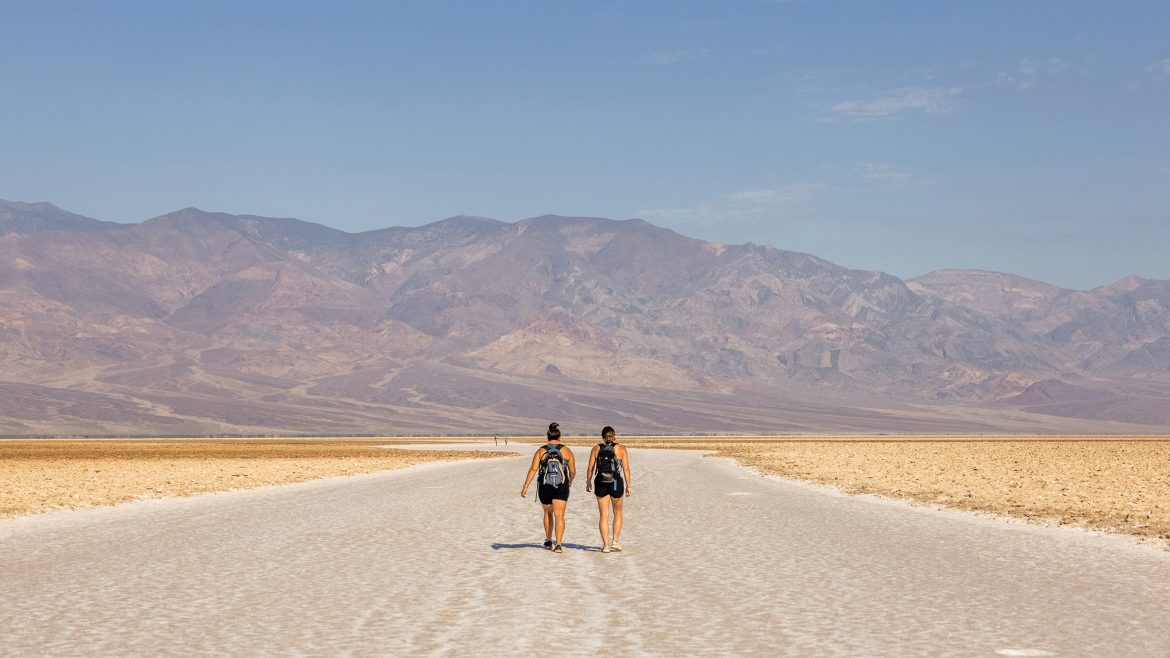This is an edition of The Weekly Planet, a newsletter that provides a guide for living through climate change. Sign up for it here.
The thermometer read 121 degrees Fahrenheit when 71-year-old Steve Curry collapsed outside a restroom in Death Valley National Park last summer. Curry, who’d reportedly been hiking on a nearby trail in Golden Canyon, was just trying to make it back to his car. The National Park Service and the Inyo County Sheriff’s Office quickly responded to the scene. They tried to revive him with an external defibrillator, but it was not enough, and the medical helicopter that could’ve transported him to a hospital wasn’t able to take off because of the extreme heat. It was too late.
One of the last photographs of Curry alive, taken by a Los Angeles Times team on the day he died, shows him sitting under a tiny patch of shade, a large sun hat on his head and his face smeared with sunscreen. When asked by the Times why he was hiking that day, the experienced hiker replied, “Why not?”
This summer, millions of visitors will descend on national parks. They may not realize that extreme heat is not only making the outdoors riskier, but also making rescuing those in danger much more difficult. Park rangers in Death Valley respond to overheated visitors multiple times a week in the summer months, and in recent years, heat has been a factor in one to three deaths there a year. High temperatures can lead to heat exhaustion and heatstroke—conditions that can necessitate a search-and-rescue operation or an air ambulance, which can reach you quicker than an ambulance on the ground. But temperatures above 120 degrees Fahrenheit (a common summer occurrence in Death Valley) make the air too “thin” to give an ambulance helicopter the lift it needs to get off the ground and safely stay there.
Without a helicopter, rescuers on the ground—braving the same blistering heat—are the only option. Although park rangers want to help, park managers will not allow them to put their lives in danger for lengthy search-and-rescue operations in extreme heat. On-foot searches for people whose location is unknown are less likely to happen when temperatures are 120 degrees or hotter in Death Valley, though park rangers will respond to medical emergencies that they can safely get to (in developed areas and along roads, for example), even in high temperatures.
These rescue challenges are likely to become more and more common at numerous national parks. Some of the most popular—Death Valley and Joshua Tree in California, Big Bend in Texas, Grand Canyon in Arizona—are in desert regions where summer is just naturally, well, hot. Death Valley once reached an air temperature of 134 degrees, at the aptly named Furnace Creek in 1913.
But even the hot places are getting hotter. In 2021, Death Valley broke its record for most consecutive days over 125 degrees; projections from a report prepared for the National Climate Assessment show that temperatures across the southwestern United States will continue to warm above previous averages throughout the rest of the century. National parks (in part because of their locations in Alaska, at high elevations, and in the arid Southwest) are disproportionately affected by climate change—from 1895 to 2010, their temperatures increased at double the rate of the rest of the country, according to research published in 2018. Last June and July, at least five people—including Curry—died in national parks in the Southwest. Heat was a contributing factor in all five deaths.
But the heat doesn’t seem to be deterring visitors. In fact, record-breaking temperatures can even be a draw. In Death Valley, many visitors are eager to get a photo in front of the park’s giant digital thermometer with its eye-popping numbers in the triple digits.
Visiting a national park is a quintessential American pastime, particularly in the summer. But in recent years, the experience of visiting a park, and other outdoor destinations, has changed alongside the climate. A study led by the NPS predicted a significant uptick in heat-related illness for its visitors in the coming years. “People should know that heat can kill, and it does,” Abby Wines, a Death Valley National Park spokesperson, told me.
Rangers and volunteers in the Grand Canyon, where hikers start the day going down and must exert themselves more on the way back up, when temperatures are higher, have since 1997 implemented a proactive approach. A “preventive” search-and-rescue team stops people before they’ve reached the canyon’s bottom, and checks on their water supplies, educates them on the day’s forecast, and encourages a U-turn if necessary.
Hikers can also take their own precautions to get ahead of an emergency. Recommendations are commonsense and easy to follow wherever you are: Drink water, shorten your activities, wear a hat, eat salty snacks, and seek out shady trails if possible. Don’t discount temperatures of 105 or 110 degrees, Wines warned, even though those numbers are “not so hot” by Death Valley standards. Low humidity in these dry places means your sweat evaporates off your body as it’s being created, getting rid of a familiar signal of exertion. And keep an eye on your watch: Hiking low-elevation trails after 10 a.m., and especially from 3 to 5 p.m., is discouraged in places like Death Valley.
Stop signs at the Golden Canyon trailhead, where Curry hiked the day of his death, warn visitors of extreme heat danger in nine different languages. Another sign shows a helicopter with a black line slashed through it, warning that a rescue may be hours away. When you see those signs, take heed.

